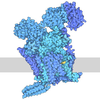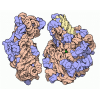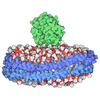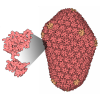[English] 日本語
 Yorodumi
Yorodumi- PDB-9ygy: Structure of a GRP94 folding intermediate engaged with a CCDC134-... -
+ Open data
Open data
- Basic information
Basic information
| Entry | Database: PDB / ID: 9ygy | ||||||
|---|---|---|---|---|---|---|---|
| Title | Structure of a GRP94 folding intermediate engaged with a CCDC134- and FKBP11-bound secretory translocon | ||||||
 Components Components |
| ||||||
 Keywords Keywords | RIBOSOME / Membrane protein / Translocon / Transport / N-Glycosylation | ||||||
| Function / homology |  Function and homology information Function and homology informationpositive regulation of MyD88-dependent toll-like receptor signaling pathway / : / positive regulation of toll-like receptor signaling pathway / oligosaccharyltransferase complex binding / actin rod assembly / oligosaccharyltransferase complex A / oligosaccharyltransferase complex B / muscle organ morphogenesis / Asparagine N-linked glycosylation / embryonic liver development ...positive regulation of MyD88-dependent toll-like receptor signaling pathway / : / positive regulation of toll-like receptor signaling pathway / oligosaccharyltransferase complex binding / actin rod assembly / oligosaccharyltransferase complex A / oligosaccharyltransferase complex B / muscle organ morphogenesis / Asparagine N-linked glycosylation / embryonic liver development / ATF6 (ATF6-alpha) activates chaperone genes / endoplasmic reticulum Sec complex / pronephric nephron development / endoplasmic reticulum chaperone complex / dolichyl-diphosphooligosaccharide-protein glycotransferase / dolichyl-diphosphooligosaccharide-protein glycotransferase activity / sequestering of calcium ion / cotranslational protein targeting to membrane / plasma membrane organization / endoplasmic reticulum quality control compartment / Ssh1 translocon complex / protein folding in endoplasmic reticulum / sarcoplasmic reticulum lumen / positive regulation of growth hormone secretion / Sec61 translocon complex / protein targeting to ER / protein insertion into ER membrane / oligosaccharyltransferase complex / post-translational protein targeting to endoplasmic reticulum membrane / positive regulation of organ growth / ventricular system development / : / : / SRP-dependent cotranslational protein targeting to membrane, translocation / XBP1(S) activates chaperone genes / signal sequence binding / SRP-dependent cotranslational protein targeting to membrane / protein N-linked glycosylation / post-translational protein targeting to membrane, translocation / endoplasmic reticulum organization / Trafficking and processing of endosomal TLR / epithelial cell apoptotic process / embryonic hemopoiesis / insulin secretion / Scavenging by Class A Receptors / epidermal growth factor binding / retrograde protein transport, ER to cytosol / azurophil granule membrane / low-density lipoprotein particle receptor binding / Insertion of tail-anchored proteins into the endoplasmic reticulum membrane / protein phosphatase inhibitor activity / sperm plasma membrane / : / cellular response to ATP / smooth endoplasmic reticulum / Advanced glycosylation endproduct receptor signaling / blastocyst development / regulation of ossification / SRP-dependent cotranslational protein targeting to membrane / protein transmembrane transporter activity / positive regulation of Wnt signaling pathway / response to type II interferon / endoplasmic reticulum unfolded protein response / cytoplasmic microtubule / : / rough endoplasmic reticulum / cellular response to manganese ion / ERAD pathway / response to cytokine / endomembrane system / endocytic vesicle lumen / protein folding chaperone / post-translational protein modification / response to endoplasmic reticulum stress / T cell activation / guanyl-nucleotide exchange factor activity / positive regulation of translation / placenta development / skeletal system development / post-embryonic development / protein localization to plasma membrane / Post-translational protein phosphorylation / peptidylprolyl isomerase / peptidyl-prolyl cis-trans isomerase activity / ATP-dependent protein folding chaperone / enzyme activator activity / positive regulation of insulin secretion / regulation of protein stability / protein modification process / Hydrolases; Acting on acid anhydrides; Acting on acid anhydrides to facilitate cellular and subcellular movement / calcium channel activity / Regulation of Insulin-like Growth Factor (IGF) transport and uptake by Insulin-like Growth Factor Binding Proteins (IGFBPs) / glucose metabolic process / unfolded protein binding / melanosome / protein folding / protein transport / : / ribosome binding / ER-Phagosome pathway Similarity search - Function | ||||||
| Biological species |  Homo sapiens (human) Homo sapiens (human) | ||||||
| Method | ELECTRON MICROSCOPY / single particle reconstruction / cryo EM / Resolution: 4.1 Å | ||||||
 Authors Authors | Yamsek, M. / Jha, R. / Keenan, R.J. | ||||||
| Funding support |  United States, 1items United States, 1items
| ||||||
 Citation Citation |  Journal: Nature / Year: 2025 Journal: Nature / Year: 2025Title: Structural basis of regulated N-glycosylation at the secretory translocon Authors: Yamsek, M. / Ma, M. / Jha, R. / Wan, Y. / Li, Q. / Zhong, F. / DeLong, K. / Ji, Z. / Rohatgi, R. / Keenan, R.J. #1: Journal: Science / Year: 2024 Title: Regulated N-glycosylation controls chaperone function and receptor trafficking. Authors: Mengxiao Ma / Ramin Dubey / Annie Jen / Ganesh V Pusapati / Bharti Singal / Evgenia Shishkova / Katherine A Overmyer / Valérie Cormier-Daire / Juliette Fedry / L Aravind / Joshua J Coon / Rajat Rohatgi /    Abstract: One-fifth of human proteins are N-glycosylated in the endoplasmic reticulum (ER) by two oligosaccharyltransferases, OST-A and OST-B. Contrary to the prevailing view of N-glycosylation as a ...One-fifth of human proteins are N-glycosylated in the endoplasmic reticulum (ER) by two oligosaccharyltransferases, OST-A and OST-B. Contrary to the prevailing view of N-glycosylation as a housekeeping function, we identified an ER pathway that modulates the activity of OST-A. Genetic analyses linked OST-A to HSP90B1, an ER chaperone for membrane receptors, and CCDC134, an ER luminal protein. During its translocation into the ER, an N-terminal peptide in HSP90B1 templates the assembly of a translocon complex containing CCDC134 and OST-A that protects HSP90B1 during folding, preventing its hyperglycosylation and degradation. Disruption of this pathway impairs WNT and IGF1R signaling and causes the bone developmental disorder osteogenesis imperfecta. Thus, N-glycosylation can be regulated by specificity factors in the ER to control cell surface receptor signaling and tissue development. | ||||||
| History |
|
- Structure visualization
Structure visualization
| Structure viewer | Molecule:  Molmil Molmil Jmol/JSmol Jmol/JSmol |
|---|
- Downloads & links
Downloads & links
- Download
Download
| PDBx/mmCIF format |  9ygy.cif.gz 9ygy.cif.gz | 1.6 MB | Display |  PDBx/mmCIF format PDBx/mmCIF format |
|---|---|---|---|---|
| PDB format |  pdb9ygy.ent.gz pdb9ygy.ent.gz | Display |  PDB format PDB format | |
| PDBx/mmJSON format |  9ygy.json.gz 9ygy.json.gz | Tree view |  PDBx/mmJSON format PDBx/mmJSON format | |
| Others |  Other downloads Other downloads |
-Validation report
| Summary document |  9ygy_validation.pdf.gz 9ygy_validation.pdf.gz | 1.9 MB | Display |  wwPDB validaton report wwPDB validaton report |
|---|---|---|---|---|
| Full document |  9ygy_full_validation.pdf.gz 9ygy_full_validation.pdf.gz | 2 MB | Display | |
| Data in XML |  9ygy_validation.xml.gz 9ygy_validation.xml.gz | 120.3 KB | Display | |
| Data in CIF |  9ygy_validation.cif.gz 9ygy_validation.cif.gz | 190.6 KB | Display | |
| Arichive directory |  https://data.pdbj.org/pub/pdb/validation_reports/yg/9ygy https://data.pdbj.org/pub/pdb/validation_reports/yg/9ygy ftp://data.pdbj.org/pub/pdb/validation_reports/yg/9ygy ftp://data.pdbj.org/pub/pdb/validation_reports/yg/9ygy | HTTPS FTP |
-Related structure data
| Related structure data |  72945MC  9n9jC M: map data used to model this data C: citing same article ( |
|---|---|
| Similar structure data | Similarity search - Function & homology  F&H Search F&H Search |
- Links
Links
- Assembly
Assembly
| Deposited unit | 
|
|---|---|
| 1 |
|
- Components
Components
-Translocon-associated protein subunit ... , 4 types, 4 molecules 5678
| #1: Protein | Mass: 32263.219 Da / Num. of mol.: 1 / Source method: isolated from a natural source / Source: (natural)  Homo sapiens (human) / References: UniProt: P43307 Homo sapiens (human) / References: UniProt: P43307 |
|---|---|
| #2: Protein | Mass: 20154.986 Da / Num. of mol.: 1 / Source method: isolated from a natural source / Source: (natural)  Homo sapiens (human) / References: UniProt: P43308 Homo sapiens (human) / References: UniProt: P43308 |
| #3: Protein | Mass: 21106.465 Da / Num. of mol.: 1 / Source method: isolated from a natural source / Source: (natural)  Homo sapiens (human) / References: UniProt: Q9UNL2 Homo sapiens (human) / References: UniProt: Q9UNL2 |
| #4: Protein | Mass: 19015.547 Da / Num. of mol.: 1 / Source method: isolated from a natural source / Source: (natural)  Homo sapiens (human) / References: UniProt: P51571 Homo sapiens (human) / References: UniProt: P51571 |
-Protein , 6 types, 6 molecules ABGJN2y3
| #5: Protein | Mass: 22213.393 Da / Num. of mol.: 1 / Source method: isolated from a natural source / Source: (natural)  Homo sapiens (human) / References: UniProt: Q9NYL4, peptidylprolyl isomerase Homo sapiens (human) / References: UniProt: Q9NYL4, peptidylprolyl isomerase |
|---|---|
| #6: Protein | Mass: 26598.648 Da / Num. of mol.: 1 / Source method: isolated from a natural source / Source: (natural)  Homo sapiens (human) / References: UniProt: Q9H6E4 Homo sapiens (human) / References: UniProt: Q9H6E4 |
| #10: Protein | Mass: 7384.762 Da / Num. of mol.: 1 / Source method: isolated from a natural source / Source: (natural)  Homo sapiens (human) / References: UniProt: Q9Y6X1 Homo sapiens (human) / References: UniProt: Q9Y6X1 |
| #12: Protein | Mass: 16844.215 Da / Num. of mol.: 1 / Source method: isolated from a natural source / Source: (natural)  Homo sapiens (human) / References: UniProt: Q9NRP0 Homo sapiens (human) / References: UniProt: Q9NRP0 |
| #17: Protein | Mass: 50854.578 Da / Num. of mol.: 1 / Source method: isolated from a natural source / Source: (natural)  Homo sapiens (human) / References: UniProt: P39656 Homo sapiens (human) / References: UniProt: P39656 |
| #20: Protein | Mass: 96254.234 Da / Num. of mol.: 1 / Source method: isolated from a natural source / Source: (natural)  Homo sapiens (human) Homo sapiens (human)References: UniProt: P14625, Hydrolases; Acting on acid anhydrides; Acting on acid anhydrides to facilitate cellular and subcellular movement |
-Protein transport protein Sec61 subunit ... , 3 types, 3 molecules DEF
| #7: Protein | Mass: 52304.406 Da / Num. of mol.: 1 / Source method: isolated from a natural source / Source: (natural)  Homo sapiens (human) / References: UniProt: P61619 Homo sapiens (human) / References: UniProt: P61619 |
|---|---|
| #8: Protein | Mass: 9987.456 Da / Num. of mol.: 1 / Source method: isolated from a natural source / Source: (natural)  Homo sapiens (human) / References: UniProt: P60468 Homo sapiens (human) / References: UniProt: P60468 |
| #9: Protein | Mass: 7752.325 Da / Num. of mol.: 1 / Source method: isolated from a natural source / Source: (natural)  Homo sapiens (human) / References: UniProt: P60059 Homo sapiens (human) / References: UniProt: P60059 |
-Dolichyl-diphosphooligosaccharide--protein glycosyltransferase subunit ... , 7 types, 7 molecules IK2L2M2NO2P2
| #11: Protein | Mass: 80607.320 Da / Num. of mol.: 1 / Source method: isolated from a natural source / Source: (natural)  Homo sapiens (human) Homo sapiens (human)References: UniProt: P46977, dolichyl-diphosphooligosaccharide-protein glycotransferase |
|---|---|
| #13: Protein/peptide | Mass: 4196.004 Da / Num. of mol.: 1 / Source method: isolated from a natural source / Source: (natural)  Homo sapiens (human) / References: UniProt: P0C6T2 Homo sapiens (human) / References: UniProt: P0C6T2 |
| #14: Protein | Mass: 9083.804 Da / Num. of mol.: 1 / Source method: isolated from a natural source / Source: (natural)  Homo sapiens (human) / References: UniProt: P61165 Homo sapiens (human) / References: UniProt: P61165 |
| #15: Protein | Mass: 12503.631 Da / Num. of mol.: 1 / Source method: isolated from a natural source / Source: (natural)  Homo sapiens (human) / References: UniProt: P61803 Homo sapiens (human) / References: UniProt: P61803 |
| #16: Protein | Mass: 14689.456 Da / Num. of mol.: 1 / Source method: isolated from a natural source / Source: (natural)  Homo sapiens (human) / References: UniProt: Q8N6L1 Homo sapiens (human) / References: UniProt: Q8N6L1 |
| #18: Protein | Mass: 68656.156 Da / Num. of mol.: 1 / Source method: isolated from a natural source / Source: (natural)  Homo sapiens (human) / References: UniProt: P04843 Homo sapiens (human) / References: UniProt: P04843 |
| #19: Protein | Mass: 69347.508 Da / Num. of mol.: 1 / Source method: isolated from a natural source / Source: (natural)  Homo sapiens (human) / References: UniProt: P04844 Homo sapiens (human) / References: UniProt: P04844 |
-Sugars , 4 types, 4 molecules
| #21: Polysaccharide | alpha-D-mannopyranose-(1-2)-alpha-D-mannopyranose-(1-3)-[alpha-D-mannopyranose-(1-3)-[alpha-D- ...alpha-D-mannopyranose-(1-2)-alpha-D-mannopyranose-(1-3)-[alpha-D-mannopyranose-(1-3)-[alpha-D-mannopyranose-(1-6)]alpha-D-mannopyranose-(1-6)]beta-D-mannopyranose-(1-4)-2-acetamido-2-deoxy-beta-D-glucopyranose-(1-4)-2-acetamido-2-deoxy-beta-D-glucopyranose Source method: isolated from a genetically manipulated source |
|---|---|
| #22: Polysaccharide | 2-acetamido-2-deoxy-beta-D-glucopyranose-(1-4)-2-acetamido-2-deoxy-beta-D-glucopyranose Source method: isolated from a genetically manipulated source |
| #23: Polysaccharide | alpha-D-mannopyranose-(1-2)-alpha-D-mannopyranose-(1-2)-alpha-D-mannopyranose-(1-3)-[alpha-D- ...alpha-D-mannopyranose-(1-2)-alpha-D-mannopyranose-(1-2)-alpha-D-mannopyranose-(1-3)-[alpha-D-mannopyranose-(1-6)-alpha-D-mannopyranose-(1-6)]beta-D-mannopyranose-(1-4)-2-acetamido-2-deoxy-beta-D-glucopyranose-(1-4)-2-acetamido-2-deoxy-beta-D-glucopyranose Source method: isolated from a genetically manipulated source |
| #24: Polysaccharide | 2-acetamido-2-deoxy-beta-D-glucopyranose-(1-4)-2-acetamido-2-deoxy-alpha-D-glucopyranose Source method: isolated from a genetically manipulated source |
-Non-polymers , 1 types, 1 molecules 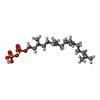
| #25: Chemical | ChemComp-ELU / |
|---|
-Details
| Has ligand of interest | Y |
|---|---|
| Has protein modification | Y |
-Experimental details
-Experiment
| Experiment | Method: ELECTRON MICROSCOPY |
|---|---|
| EM experiment | Aggregation state: PARTICLE / 3D reconstruction method: single particle reconstruction |
- Sample preparation
Sample preparation
| Component | Name: Nascent GRP94 folding intermediate bound to a ribosome-translocon complex Type: COMPLEX Details: Isolated by affinity purification via a Flag-tag on FKBP11 Entity ID: #1-#20 / Source: NATURAL | |||||||||||||||||||||||||||||||||||
|---|---|---|---|---|---|---|---|---|---|---|---|---|---|---|---|---|---|---|---|---|---|---|---|---|---|---|---|---|---|---|---|---|---|---|---|---|
| Molecular weight | Experimental value: NO | |||||||||||||||||||||||||||||||||||
| Source (natural) | Organism:  Homo sapiens (human) / Organelle: Endoplasmic reticulum Homo sapiens (human) / Organelle: Endoplasmic reticulum | |||||||||||||||||||||||||||||||||||
| Buffer solution | pH: 7.4 Details: HEPES buffer was adjusted to pH 7.4 with potassium hydroxide. | |||||||||||||||||||||||||||||||||||
| Buffer component |
| |||||||||||||||||||||||||||||||||||
| Specimen | Conc.: 0.056 mg/ml / Embedding applied: NO / Shadowing applied: NO / Staining applied: NO / Vitrification applied: YES Details: Native ribosome-translocon complexes isolated from HEK293 microsomes by affinity purification via a Flag-tag on FKBP11 | |||||||||||||||||||||||||||||||||||
| Specimen support | Grid material: GOLD / Grid mesh size: 400 divisions/in. / Grid type: Quantifoil R1.2/1.3 | |||||||||||||||||||||||||||||||||||
| Vitrification | Instrument: FEI VITROBOT MARK IV / Cryogen name: ETHANE / Humidity: 100 % / Chamber temperature: 295 K Details: Three microliters of affinity-purified RTCs were applied to the grid, incubated for 60 seconds, blotted for 7 seconds, drained for 0.5 seconds, and frozen in liquid nitrogen-cooled ethane. |
- Electron microscopy imaging
Electron microscopy imaging
| Experimental equipment |  Model: Titan Krios / Image courtesy: FEI Company |
|---|---|
| Microscopy | Model: TFS KRIOS |
| Electron gun | Electron source:  FIELD EMISSION GUN / Accelerating voltage: 300 kV / Illumination mode: FLOOD BEAM FIELD EMISSION GUN / Accelerating voltage: 300 kV / Illumination mode: FLOOD BEAM |
| Electron lens | Mode: BRIGHT FIELD / Nominal magnification: 53000 X / Nominal defocus max: 1900 nm / Nominal defocus min: 900 nm / Cs: 2.7 mm |
| Specimen holder | Cryogen: NITROGEN / Specimen holder model: FEI TITAN KRIOS AUTOGRID HOLDER |
| Image recording | Electron dose: 60 e/Å2 / Film or detector model: GATAN K3 BIOQUANTUM (6k x 4k) / Num. of grids imaged: 1 / Num. of real images: 6569 |
- Processing
Processing
| EM software |
| ||||||||||||||||
|---|---|---|---|---|---|---|---|---|---|---|---|---|---|---|---|---|---|
| CTF correction | Type: NONE | ||||||||||||||||
| Particle selection | Num. of particles selected: 741983 | ||||||||||||||||
| 3D reconstruction | Resolution: 4.1 Å / Resolution method: FSC 0.143 CUT-OFF / Num. of particles: 55750 / Num. of class averages: 1 / Symmetry type: POINT | ||||||||||||||||
| Atomic model building | Protocol: FLEXIBLE FIT / Space: REAL Details: Tightly restrained real-space refinement in Coot and Phenix | ||||||||||||||||
| Refinement | Cross valid method: NONE |
 Movie
Movie Controller
Controller



 PDBj
PDBj